Fusion sometimes gets a bad rep on the culinary mean streets, especially among the purists, regionalists and the more stubborn keepers of convention. While I agree that the grand majority of attempts to fuse two distant cuisines in one plate end in a tacky mess, I do appreciate the effort when research is conducted and the not-so-obvious common grounds and fundamental differences are examined in the process. Examples? When a texture achieved by some ingredient in some signature dish of some region is delivered to an unrelated dish by a very different ingredient. When a Western style of preparation is used on Eastern ingredients, and vice versa. Fusion has to be subtle to work and it has to focus on core characteristics of the 2+ cuisines, not on the surface ones. A beef stroganoff taco would be stupid. So would a tandoori chicken gelato. But many classic dishes, entire cuisines even, were historically born from fusion cooking. Just think of Louisiana Creole, which blends the U.S. Southern style with French, Spanish, Portuguese, Italian, Native American and African influences to make some of the most beloved dishes in the U.S. Think of the bahn mi. Today, fusion cuisine is a way of keeping things relevant and preventing the stagnation of cooking style. And by bringing an “ooh-aah” factor to the dinner table it is also a way of getting restaurant-goers to try something new. The latter seems to be the goal at least of many chefs I’ve spoken to.
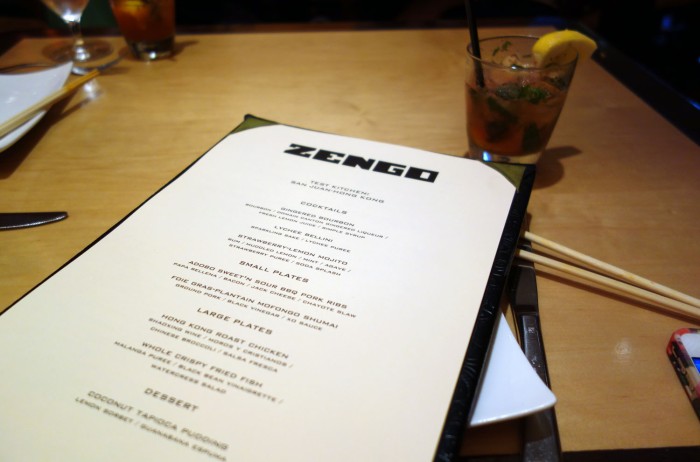 It was with fusion in mind that I threw myself into Richard Sandoval and Chef de Cuisine Graham Bartlett’s newest Test Kitchen series at Zengo in Chinatown. Every few months the culinary team at Zengo develops a prix fixe TK tasting menu in which they fuse the cuisines of one Latin American and one Asian country. In the case of this summer’s TK menu (available until September 30th), the flavors and textures of San Juan, Puerto Rico are blended with those of Hong Kong within individual dishes. I feel pretty comfortable with the characteristics of Hong Kong’s cuisine but was curious of how these would successfully be applied to the heavier, heartier rice-beans-yuca type dishes popular in SJ. The blending of the two resulted in a fun experience, a night of my dining companion and I searching for flavoral components from each culture of cooking. There were a few things that didn’t make too much sense at all, but there were also sparks of innovation and creative thinking.
It was with fusion in mind that I threw myself into Richard Sandoval and Chef de Cuisine Graham Bartlett’s newest Test Kitchen series at Zengo in Chinatown. Every few months the culinary team at Zengo develops a prix fixe TK tasting menu in which they fuse the cuisines of one Latin American and one Asian country. In the case of this summer’s TK menu (available until September 30th), the flavors and textures of San Juan, Puerto Rico are blended with those of Hong Kong within individual dishes. I feel pretty comfortable with the characteristics of Hong Kong’s cuisine but was curious of how these would successfully be applied to the heavier, heartier rice-beans-yuca type dishes popular in SJ. The blending of the two resulted in a fun experience, a night of my dining companion and I searching for flavoral components from each culture of cooking. There were a few things that didn’t make too much sense at all, but there were also sparks of innovation and creative thinking.
 Dinner started with a Lychee Bellini, sparkling sake and lychee puree, a very simple little cocktail with a delicate sweetness backed with a light fizz in texture. The puree was not too diluted by the sparkling sake and there was still plenty of moist lychee pulp in the drink to make it rich and satisfying. A liquid amuse bouche just enough for three mouthfuls, the blend of acidity and sweetness polishing the palate to get it ready for what was to come.
Dinner started with a Lychee Bellini, sparkling sake and lychee puree, a very simple little cocktail with a delicate sweetness backed with a light fizz in texture. The puree was not too diluted by the sparkling sake and there was still plenty of moist lychee pulp in the drink to make it rich and satisfying. A liquid amuse bouche just enough for three mouthfuls, the blend of acidity and sweetness polishing the palate to get it ready for what was to come.

 First came the Foie Gras-Plantain Mofongo Shumai, a funky little dim sum plate good for sharing. Mofongo is a Puerto Rican dish with fried plantains mashed together with oil, garlic and pork cracklings. In this case a mildly seasoned mofongo was incorporated into a pork shumai, adding a mushy sweet, starchy element to blend with the meat. The traditional flavoring of the mofongo was, in a way, replaced by the Hong Kongese XO topping – dried shrimp and dried pork in a garlic, chili crust adding a chewy texture and a fishy, salty element. I took the soft steamed dumpling in one bite. Towards the center my tongue pushed up against a silky smooth, buttery mass which ended up being foie gras used mainly for texture rather than flavor. The foie was piped into the shumai and allowed to melt a bit during the steaming process. So, in a way this was a fusion of a shumai and a xiao long bao with plantains adding an additional layer of flavor. The shumai was served with black vinegar sauce to add an additional zang and round things out with the XO. The dish was a bit too busy and I didn’t get to appreciate each ingredient as much as I had wanted to (especially the foie), but a good idea nonetheless.
First came the Foie Gras-Plantain Mofongo Shumai, a funky little dim sum plate good for sharing. Mofongo is a Puerto Rican dish with fried plantains mashed together with oil, garlic and pork cracklings. In this case a mildly seasoned mofongo was incorporated into a pork shumai, adding a mushy sweet, starchy element to blend with the meat. The traditional flavoring of the mofongo was, in a way, replaced by the Hong Kongese XO topping – dried shrimp and dried pork in a garlic, chili crust adding a chewy texture and a fishy, salty element. I took the soft steamed dumpling in one bite. Towards the center my tongue pushed up against a silky smooth, buttery mass which ended up being foie gras used mainly for texture rather than flavor. The foie was piped into the shumai and allowed to melt a bit during the steaming process. So, in a way this was a fusion of a shumai and a xiao long bao with plantains adding an additional layer of flavor. The shumai was served with black vinegar sauce to add an additional zang and round things out with the XO. The dish was a bit too busy and I didn’t get to appreciate each ingredient as much as I had wanted to (especially the foie), but a good idea nonetheless.
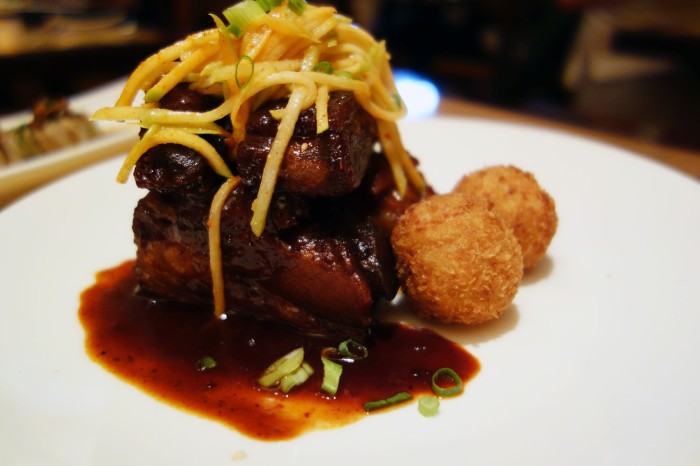
 Next came a heartier dim sum, the Adobo Sweet and Sour BBQ Pork Ribs, served with bacon and jack cheese papas rellenas and chayote slaw. When in Chinatown, I would definitely pop in at Zengo just for this dish. Fortunately, it also appears on the a la carte menu, making the latter possible even without repeating the entire dinner. The juicy, tender meat slid right off bone. Large hunks of translucent cartilage were soft enough to bite through and eat as well. The meat was cooked in a way very much reminiscent of pork ribs I’ve picked off mounds of rice at little eateries near the butcher shops of Sai Ying Pun. A sticky sweet adobo sauce gripped the meat tight. I could taste more of the cider vinegar and sugar than chiles in the sauce and, in fact, it wasn’t really spicy at all. It didn’t really need to be. In this case the ribs were largely Hong Kongese, while the side added the Latin factor. The papas rellenas were fantastic to mop the rest of the sauce up with. I must say I’m glad there were only two on the plate, because I easily could’ve snacked on a whole basket of these and the ribs were already pretty filling on their own. Panco-coated balls of creamy mashed potato blended with bits of bacon. A gooey, melted jack cheese center. The meat was topped with very lightly cooked chayote, julienned together with some tart apple into a slaw to contrast the richness of the dish with its tart flavor and fresh, crisp texture. It reminded me a bit of Thai Som Tum (green papaya salad) but without the heat. Maybe adding a bit of chili powder to these would’ve been nice as well.
Next came a heartier dim sum, the Adobo Sweet and Sour BBQ Pork Ribs, served with bacon and jack cheese papas rellenas and chayote slaw. When in Chinatown, I would definitely pop in at Zengo just for this dish. Fortunately, it also appears on the a la carte menu, making the latter possible even without repeating the entire dinner. The juicy, tender meat slid right off bone. Large hunks of translucent cartilage were soft enough to bite through and eat as well. The meat was cooked in a way very much reminiscent of pork ribs I’ve picked off mounds of rice at little eateries near the butcher shops of Sai Ying Pun. A sticky sweet adobo sauce gripped the meat tight. I could taste more of the cider vinegar and sugar than chiles in the sauce and, in fact, it wasn’t really spicy at all. It didn’t really need to be. In this case the ribs were largely Hong Kongese, while the side added the Latin factor. The papas rellenas were fantastic to mop the rest of the sauce up with. I must say I’m glad there were only two on the plate, because I easily could’ve snacked on a whole basket of these and the ribs were already pretty filling on their own. Panco-coated balls of creamy mashed potato blended with bits of bacon. A gooey, melted jack cheese center. The meat was topped with very lightly cooked chayote, julienned together with some tart apple into a slaw to contrast the richness of the dish with its tart flavor and fresh, crisp texture. It reminded me a bit of Thai Som Tum (green papaya salad) but without the heat. Maybe adding a bit of chili powder to these would’ve been nice as well.
 Following the appetizers came the Strawberry-Lemon Mojito with rum, muddled lemon, mint, agave, strawberry puree and soda splash. Light and refreshing, not too sweet because of the incorporation of agave, tiny strawberry seeds floating around to add a sense of freshness. The strawberry flavor was delicate enough not to fight with the mint, but present enough not to be overshadowed by the icy cool effect of the latter. Another good palate cleanser.
Following the appetizers came the Strawberry-Lemon Mojito with rum, muddled lemon, mint, agave, strawberry puree and soda splash. Light and refreshing, not too sweet because of the incorporation of agave, tiny strawberry seeds floating around to add a sense of freshness. The strawberry flavor was delicate enough not to fight with the mint, but present enough not to be overshadowed by the icy cool effect of the latter. Another good palate cleanser.
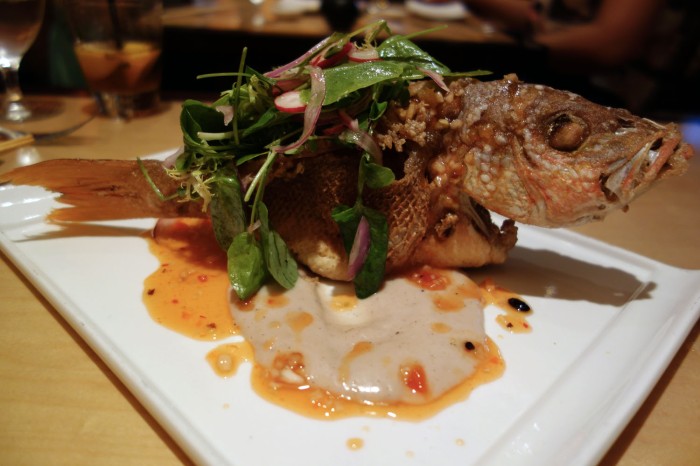


 I like a bit of biology when it comes to my dinner and the Whole Crispy Fried Fish was a fun one to dissect. When is whole fish not a crowd pleaser? This one is a great date dish, as it gives the guy the opportunity to filet something and serve his lady. Of course, ignoring etiquette and tearing right into the thing is another option. The fried red snapper had been largely deboned and sat onto a malanga puree with a sweet and sour black bean vinaigrette trickling off into it from the fresh watercress salad topping the fish. I enjoyed the presentation of the fish and the gutsy ideas behind the unconventional dish. This was not a squeeze-of-lemon, sprig-of-dill, light-as-a-feather summertime fish filet. The flesh still had some Y-bones clinging to it. Most of the extremities were left on and these crisped up like fishy fries, easy to pull off and crunch on. But the rest of the animal was very much a project to take apart and pick through: collar, cheek meat, crispy tail. It had a tad too much fried coating, making it difficult to get to the meat itself, the latter of which seemed to have been a bit overcooked. But the process of picking through the thing was entertaining enough. The malanga was a starchy, dense, slimy puree like a puddle of mud for the fish to splash around in. It slid down the throat almost like a liquid raw dough, leaving behind a natural root sweetness that reminded me of taro root which, I later found out, the vegetable is in fact related to. The murky flavors and denseness of the puree were picked up by the tart black bean vinaigrette (here is where the fusion of two cuisines came into play) and the fresh watercress and red onion salad topping the fish. To this day I can’t really decide how I feel about this dish but it was definitely unlike any I’ve had before.
I like a bit of biology when it comes to my dinner and the Whole Crispy Fried Fish was a fun one to dissect. When is whole fish not a crowd pleaser? This one is a great date dish, as it gives the guy the opportunity to filet something and serve his lady. Of course, ignoring etiquette and tearing right into the thing is another option. The fried red snapper had been largely deboned and sat onto a malanga puree with a sweet and sour black bean vinaigrette trickling off into it from the fresh watercress salad topping the fish. I enjoyed the presentation of the fish and the gutsy ideas behind the unconventional dish. This was not a squeeze-of-lemon, sprig-of-dill, light-as-a-feather summertime fish filet. The flesh still had some Y-bones clinging to it. Most of the extremities were left on and these crisped up like fishy fries, easy to pull off and crunch on. But the rest of the animal was very much a project to take apart and pick through: collar, cheek meat, crispy tail. It had a tad too much fried coating, making it difficult to get to the meat itself, the latter of which seemed to have been a bit overcooked. But the process of picking through the thing was entertaining enough. The malanga was a starchy, dense, slimy puree like a puddle of mud for the fish to splash around in. It slid down the throat almost like a liquid raw dough, leaving behind a natural root sweetness that reminded me of taro root which, I later found out, the vegetable is in fact related to. The murky flavors and denseness of the puree were picked up by the tart black bean vinaigrette (here is where the fusion of two cuisines came into play) and the fresh watercress and red onion salad topping the fish. To this day I can’t really decide how I feel about this dish but it was definitely unlike any I’ve had before.
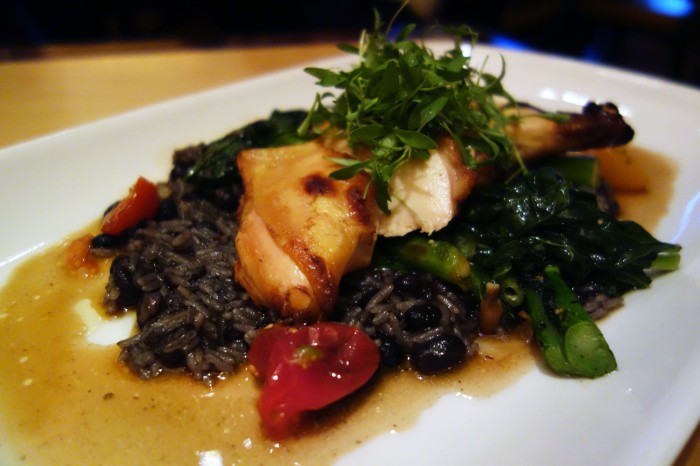
 Our second entree was the Hong Kong Roast Chicken, prepared with Shaoxing wine, moros y cristianos (rice and black beans), lightly sauteed Chinese broccoli and a few plump grape tomatoes, which I think were also touched with the rice wine. The chicken was very tender. The very thin skin echoed the characteristic flavors of the rice wine, which gave it a wonderful flavoral depth, a sweetness and a sticky texture, as well as the Hong Kong essence. The meat was nicely paired with starchy, satisfying rice and beans which was lightened up by the tangy tomato salsa. Definitely a more modest dish but the message came through in its simplicity. Chicken, rice and beans – Latin America’s perhaps most representative combination – but with the chicken prepared in a Hong Kongese style and paired with some familiar veggies. An every day kind of fusion dish to contrast the excess of the shumai.
Our second entree was the Hong Kong Roast Chicken, prepared with Shaoxing wine, moros y cristianos (rice and black beans), lightly sauteed Chinese broccoli and a few plump grape tomatoes, which I think were also touched with the rice wine. The chicken was very tender. The very thin skin echoed the characteristic flavors of the rice wine, which gave it a wonderful flavoral depth, a sweetness and a sticky texture, as well as the Hong Kong essence. The meat was nicely paired with starchy, satisfying rice and beans which was lightened up by the tangy tomato salsa. Definitely a more modest dish but the message came through in its simplicity. Chicken, rice and beans – Latin America’s perhaps most representative combination – but with the chicken prepared in a Hong Kongese style and paired with some familiar veggies. An every day kind of fusion dish to contrast the excess of the shumai.
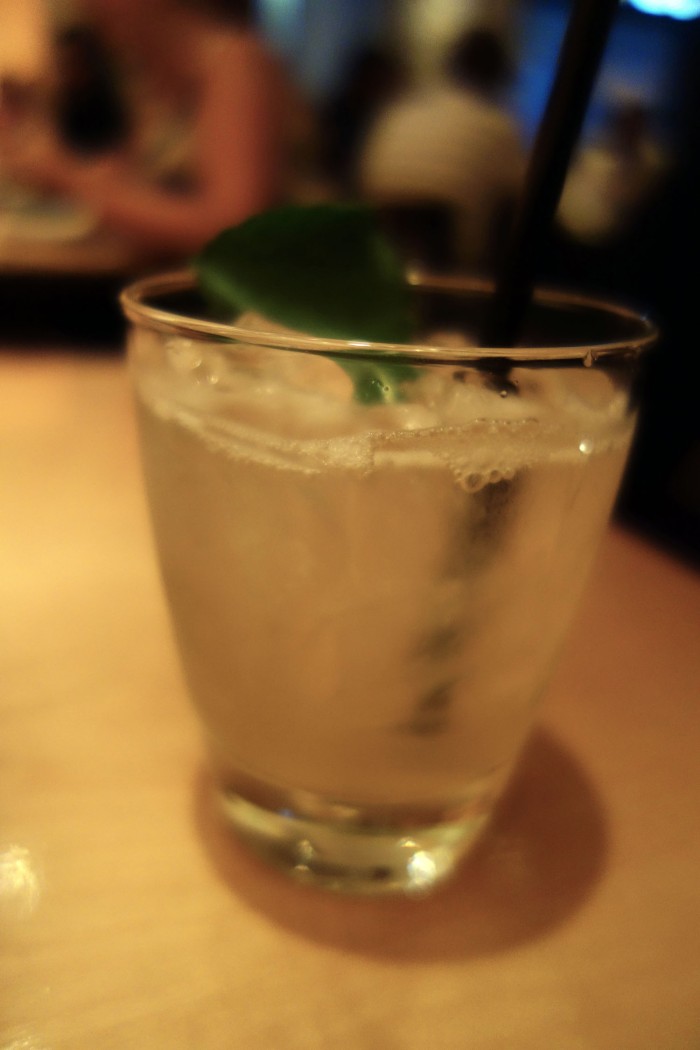 Our third drink of the night was the Gingered Bourbon with a base of Bourbon shaken with Domain Canton gingered liqueur, fresh lemon juice and simple syrup. The simplest one
Our third drink of the night was the Gingered Bourbon with a base of Bourbon shaken with Domain Canton gingered liqueur, fresh lemon juice and simple syrup. The simplest one


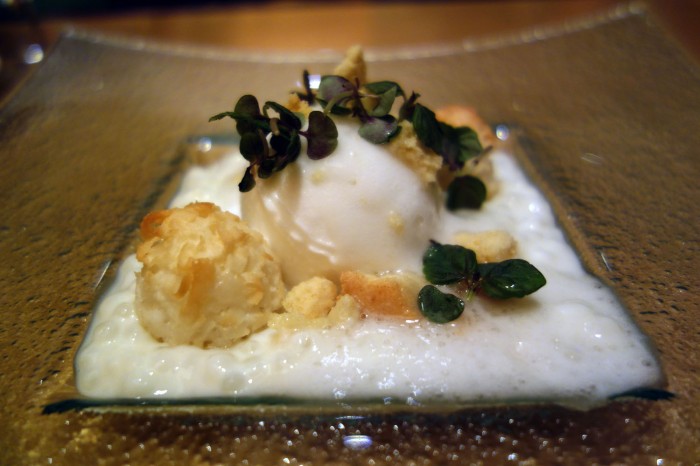 For dessert, Coconut Tapioca Pudding with lemon sorbet, guanabana espuma and coconut macaroons. The little ball of sorbet was tart and cool, wiping my mouth clean of the intense flavors of the meal. This was sitting in a pool of tapioca pudding whose floral sweetness and soft, bumpy texture contrasted well with the harsh frost of the former. The guanabana espuma was nice, giving the dish an element of fruity sweetness, though the foam had melted down to a frothy soup by the time it got to our table and had to be mixed with the tapioca pudding to have any texture at all. Coconut macaroons were a tad dry for my taste but a cute idea. The bits of shortbread might have been sufficient as a flaky, crunchy element to contrast the creamy ingredients of the dish. The dessert achieved a nice harmony between the two dessert ideologies. On the Asian side, it wasn’t too sweet, the flavors were relatively mild and intrigue came from that mushy, bubbly tapioca texture I’ve come to miss in sago and tapioca shaved ice. On the Latin American side, the mild sweetness of the guanabana was balanced out by tart, fresh lemon and sweet coconut.
For dessert, Coconut Tapioca Pudding with lemon sorbet, guanabana espuma and coconut macaroons. The little ball of sorbet was tart and cool, wiping my mouth clean of the intense flavors of the meal. This was sitting in a pool of tapioca pudding whose floral sweetness and soft, bumpy texture contrasted well with the harsh frost of the former. The guanabana espuma was nice, giving the dish an element of fruity sweetness, though the foam had melted down to a frothy soup by the time it got to our table and had to be mixed with the tapioca pudding to have any texture at all. Coconut macaroons were a tad dry for my taste but a cute idea. The bits of shortbread might have been sufficient as a flaky, crunchy element to contrast the creamy ingredients of the dish. The dessert achieved a nice harmony between the two dessert ideologies. On the Asian side, it wasn’t too sweet, the flavors were relatively mild and intrigue came from that mushy, bubbly tapioca texture I’ve come to miss in sago and tapioca shaved ice. On the Latin American side, the mild sweetness of the guanabana was balanced out by tart, fresh lemon and sweet coconut.
The Hong Kong – San Juan Test Kitchen menu at Zengo is fusion for the sake of fun. While some dishes surrendered balance for excess, others stayed classy in their more delicate incorporation of fusion. Playful combinations and a sense of humor in each dish. An adventure, as any fusion meal should be.


